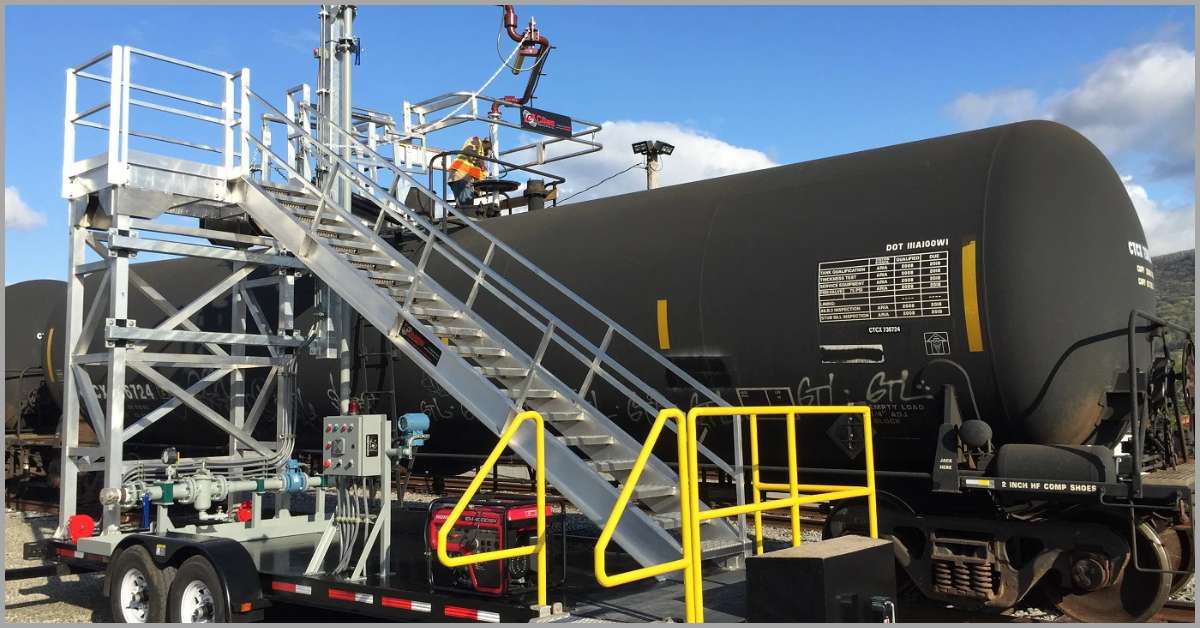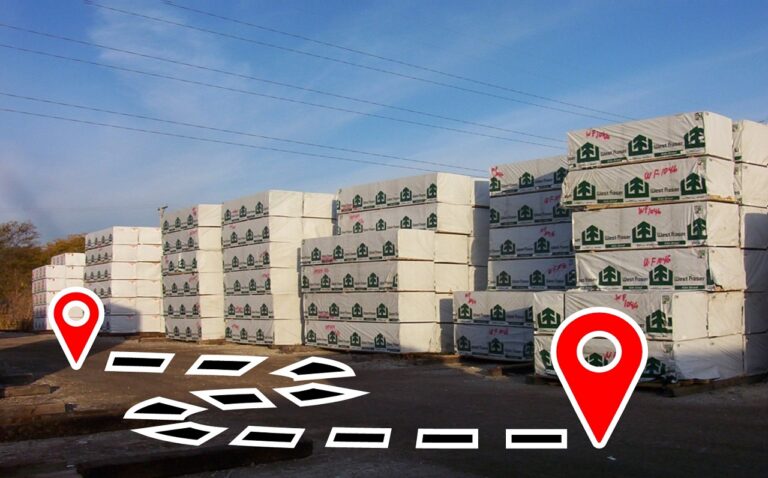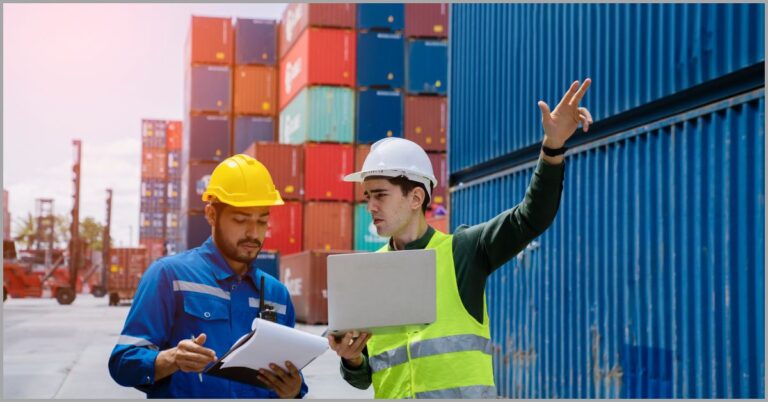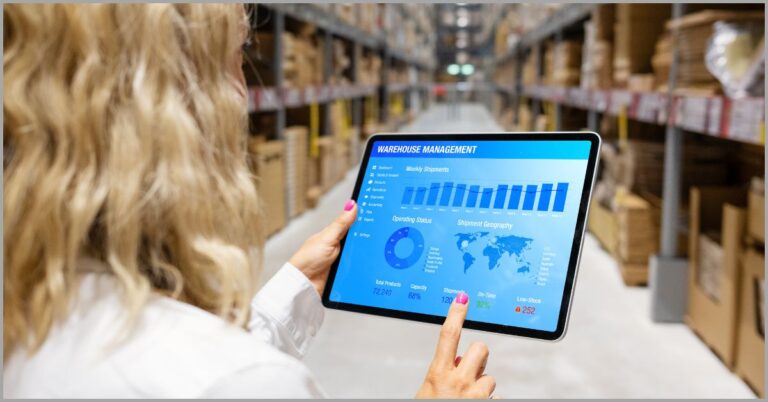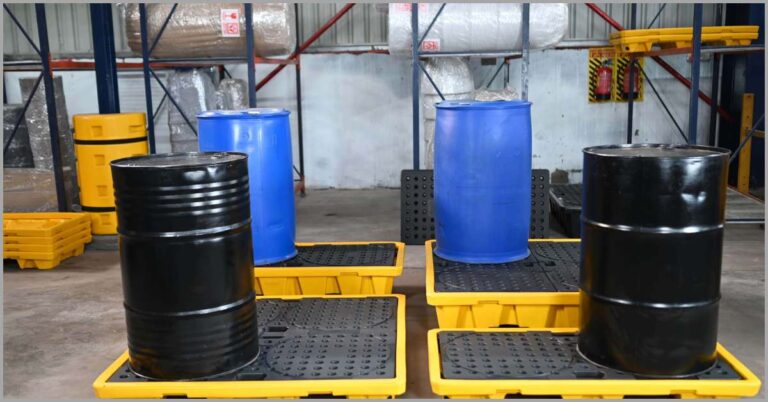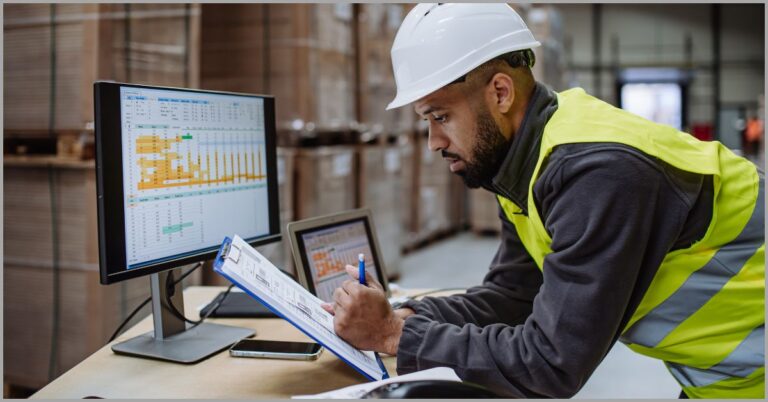Mobile Transloading Systems: Definition, Benefits & Challenges Guide in 2024
Considering a mobile transloading system for your business?
This is an important transloading equipment that can massively boost efficiency.
However, mobile transloading systems typically require huge capital investments, so it’s crucial to understand what they offer and if they’re right for your needs.
A Statista survey established that 66% of logistics companies face technology investment challenges. Some of these issues arise from dilemmas regarding what equipment to invest in.
In order to help you avoid making regrettable purchases, we’ll examine what mobile transloading units are and what they bring to the table. You’ll also learn about the key challenges and compliance issues they attract.
With this information, you can make a more informed decision about whether a portable transloading unit is a great investment decision for your transloading company.
If your business deals with transferring cargo between containers, check out this article I wrote about container transloading techniques for improving productivity.
In this article, we’ll discuss mobile transloading systems in our definition, benefits and challenges guide to help you improve transloading operations and profit margins.
Let’s get started.
What is a mobile transloading system?
A mobile transloading system is a piece of portable equipment that enables you to perform transloading at different sites in your facility or beyond.
It consists of a portable platform that lets you reach the top hatches of tankers, while it may also contain other important tools within the same system. These include pumps, compressors, meters and other equipment necessary for transloading.
Oftentimes, your transloading activities can be restricted to a dedicated workspace or loading dock, which hinders productivity and efficiency.
A portable transloading unit breaks these limitations by untethering physical barriers.
For example, instead of performing transloading at a dedicated zone of your transloading warehouse with fixed equipment, these units enable you to go to the rail or truck tanker you need to transload and perform the activity from there.
This could be a different zone in your transloading warehouse or to a different site altogether if the tanker is unable to get to your transloading facility.
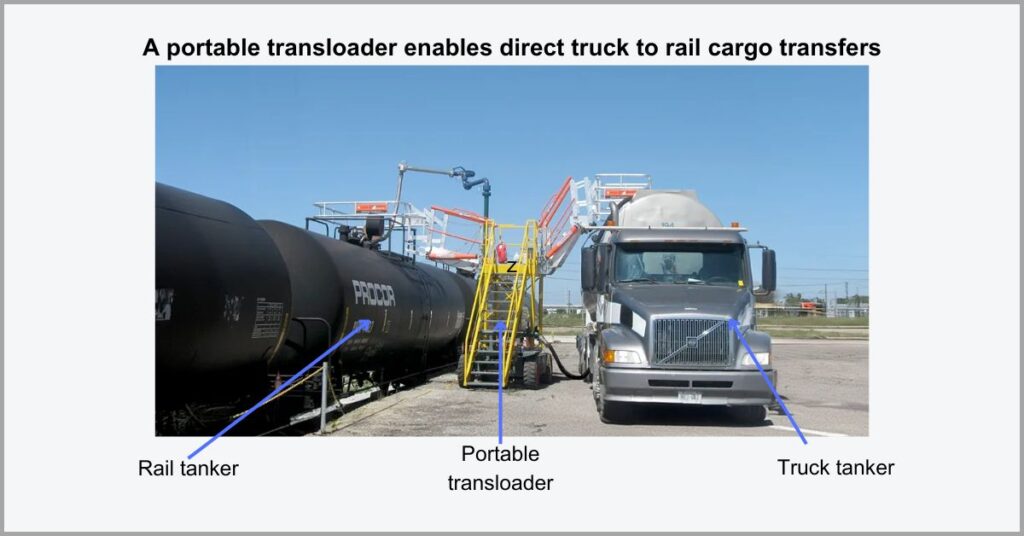
It can also come in handy when you need to transload commodities for truck tankers that have broken down. In such cases, you can move the mobile transloading unit to the location, and transload the commodity to a different, mechanically-fit truck.
That said, these systems are mostly commonly used for liquid bulk material transfers. So it’s a popular equipment during butane transload shipping, where it enables the safe and efficient transfer of the product between rail and truck tankers.
For all their usefulness, mobile transloading systems require meticulous coordination between your field and backoffice crew to ensure safe and efficient transloading. This is why I recommend using a transloading software to streamline communication gaps.
Click here to book your free transloads.co demo to explore our software’s collaboration features.
You’ll learn how you use our worker management dashboard to communicate & assign tasks to field crew efficiently so that off-site transloading tasks proceed smoothly.
Benefits of a mobile transloading unit for your business
1. Reduced yard congestion
Does your business have a centralized loading zone?
You may rely on dedicated loading docks or specific warehouse zones for your loading operations. These may even have important transloading equipment, like palletizer machines, example, that are fixed in place and therefore immobile.
However, centralized loading areas can increase yard congestion during periods of high demand, thereby slowing transloading operations and throughput.
A survey by Vector discovered that 41% of yards suffer from excessive driver detention and dwell time resulting from yard congestion. This has inflated operational expenses and also strained relationships with customers.
With a portable transloading unit, you can reduce congestion at docks and gates to streamline the movement of both trucks and goods inside your transload yard.
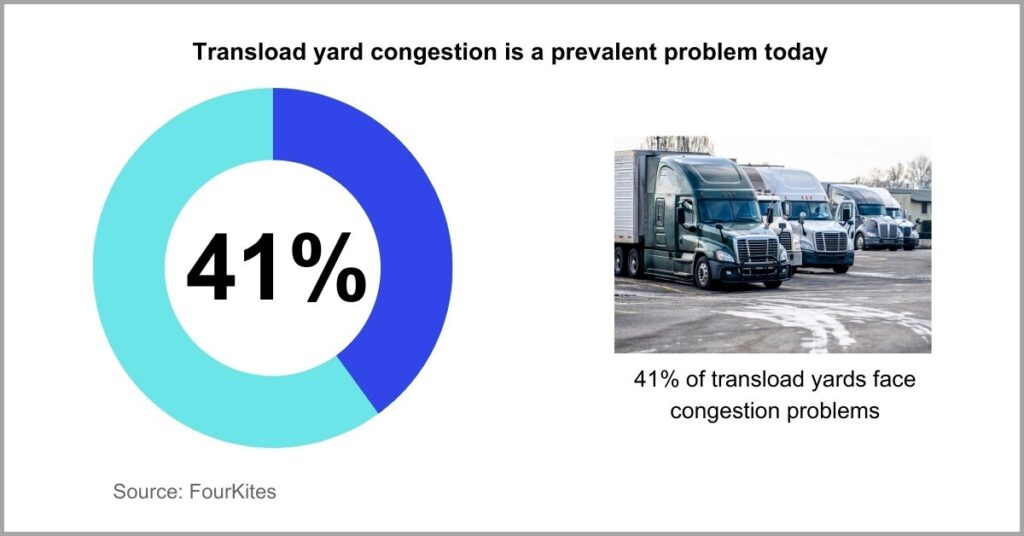
It enables you to get around logistical gridlocks in your yard by diversifying your loading zones and reducing your dependence on scarce resources like loading docks.
For example, instead of performing transloading and cross-docking activities at a specific loading zone, this equipment enables you to cut out the loading dock altogether.
You can now perform direct truck-to-truck cargo transfers efficiently and remotely, which frees up docks as well as personnel to handle other key tasks for your transload yard.
With lower yard congestion, cases of driver detention and shipping delays decrease.
You can keep truck traffic flowing more efficiently in your yard, ensuring that truckers don’t miss their pickups or get delayed. When this happens, you can avoid expensive driver detention fees and strengthen your relationships with customers.
2. Lower warehousing needs
Inventory holding is part and parcel of transloading.
This is because you often need to temporarily store offloaded goods in your warehouse, either for storage awaiting pickup or for palletization if requested by your client.
That said, holding too much inventory on site eats up a lot of valuable storage space, which can stall your business and invite additional space renting needs.
A study by McKinsey revealed that 58% of supply chain leaders say optimizing inventory levels is their biggest priority. They view it as pivotal to lowering their inventory holding needs, and cutting out recurring business costs.
When you keep too much inventory, it can force you to acquire more real estate during periods of high demand, which only increases your operational expenses.
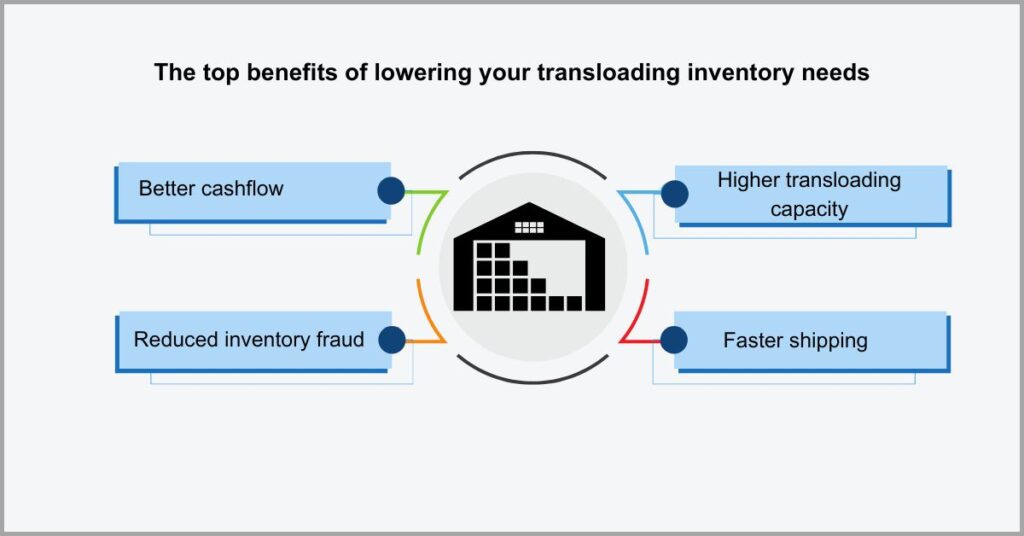
But how does a portable transloading unit reduce your inventory needs?
This equipment is a valuable asset for executing strategies like just-in-time shipping.
It’s a tactic where goods arrive exactly when needed, ensuring that you can transfer them directly from one mode of transportation to another with minimal wait time.
A mobile transloading system facilitates this strategy by enabling direct truck to truck cargo transfers or rail to truck transloading, which decreases your warehousing needs. In fact, it completely eliminates this if the recipient is ready for pickup.
What’s more, some of these units also come equipped with large storage capacity containers. So they can even hold the cargo in the field pending the arrival of the pickup carrier, further reducing the need of holding liquid bulk inventory in your warehouse.
3. Improved safety
How safe is your transloading facility?
Transloading is sometimes a very high risk affair, especially when you’re transloading dangerous liquid bulk cargo such as butane and other crude oil products.
Aside from the risk of fires and explosions, your transload operators can easily slip and fall off the top of tanker hatches, resulting in costly worker injuries.
In fact, over 97% of dock workers are concerned about their physical safety at work, according to a survey by AlertMedia. Given that they work in close proximity to dangerous machinery and hazards, this fear is perfectly justifiable.
When workers are injured, your yard can suffer huge financial setbacks. For example, a single OSHA violation can cost your business up to $70,000 in fines for repeat offenses.
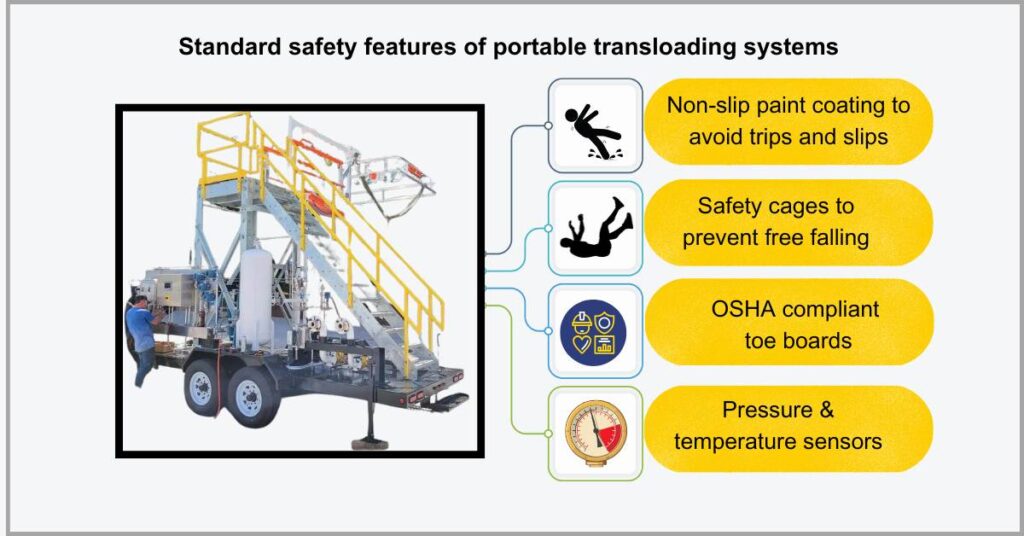
While it can’t completely eliminate the risk of an accident or injury, the right portable transloading unit significantly minimizes the chances of it occurring in the first place.
Consequently, it is a popular tool for different types of transloading activities, although it is most commonly used for performing safe liquid bulk freight transfers.
This is because it comes with important safety access features, including gangways with safety cages. The cage easily rotates between trucks and railcars, while you can also lock it in place to prevent sudden movements.
So instead of using dangerous ladders, you can safely access the top hatches of tankers. You can also get other fall protection measures and safety features like temperature & pressure sensors that help you create a safer transloading workflow.
4. Increased productivity & efficiency
Worker productivity directly determines your revenue.
When your transloaders aren’t working at their full potential, you’ll be able to complete fewer transloading tasks at a given time and so you may take on fewer projects.
With inefficient transloading practices, the time spent on iterative work will only increase, thereby reducing worker output and, ultimately, your bottom line.
In fact, distribution centers lose 3,000 work hours annually to unproductive workflows, according to an Intermec study. It goes on to add that 20% of these managers rated packing and loading as the most inefficient operations for their businesses.
This made loading operations the most problematic of their workflow, ranking ahead of picking and inventory control issues, which ranked second and third overall.
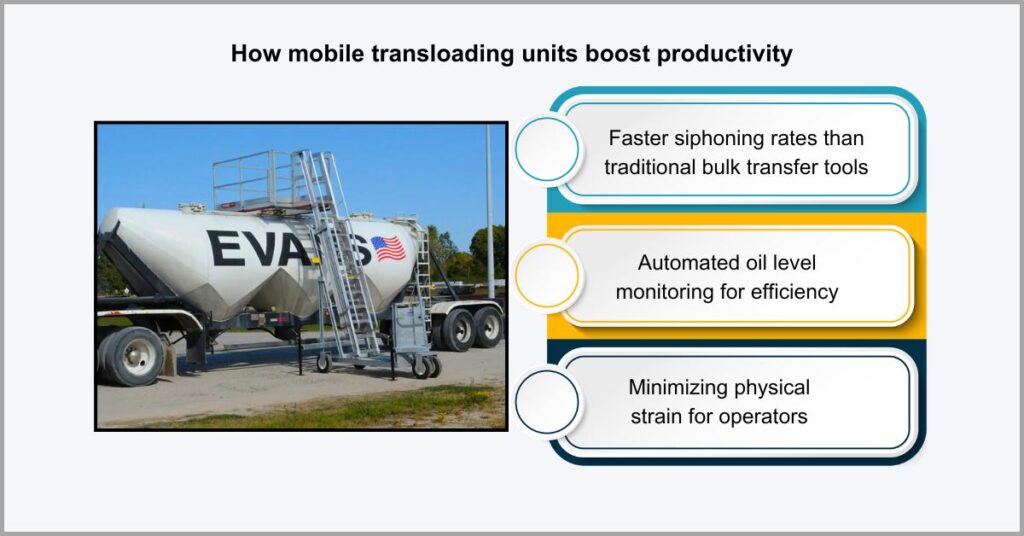
So how does a mobile transloading system boost productivity?
First, it can help you solve key transloading challenges such as productivity losses by making your transload yard’s operations more time and effort efficient.
Instead of transload operators and dock workers having to constantly travel back and forth between railcars and trucks transferring products, a portable transloading unit minimizes this movement with large capacity cargo switches.
Speaking of improving efficiency, we also offer transloading consultancy services that help you take your transload yard operations to the next level.
Click here to get our premium support services to turbocharge yard productivity.
With our assistance, you can not only optimize warehouse operations for increased efficiency but also upskill workers to create a safer and faster transloading workflow.
5. Transloading workflow decentralization
Want to diversify and expand your reach?
Oftentimes, your transloading operations may be tethered to one physical area, which contains the infrastructure and equipment you need to carry out your operations.
While a centralized workflow makes logistics easier to manage, it can also limit your market reach and your ability to provide end-to-end transloading solutions.
In fact, 9 out of 10 logistics leaders said customers greatly prioritize a broader range of services from logistics companies, according to an Accenture study. One great example that you can offer as you expand your offerings is portable transloading solutions.
Failing to diversify and provide such services can blunt your competitive edge, and also limit your ability to generate the additional revenue you need to spur growth.
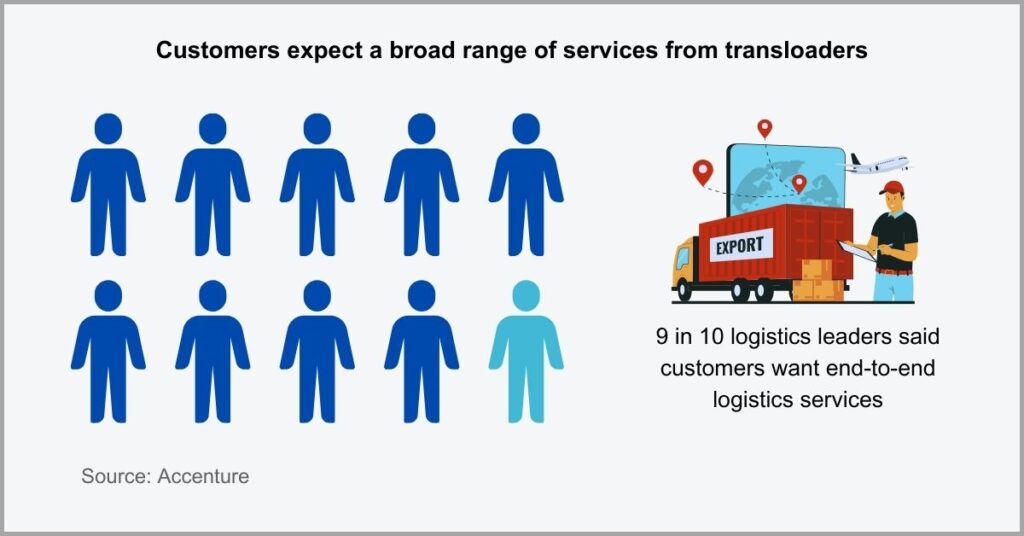
By decentralizing your workflow, a mobile transloading unit enables you to get to your customers wherever they are, rather than requiring them to come to you.
For example, during crude oil transloading, you may receive clients who’ve requested your transloading services to help move the oil from truck tankers to railcars.
Their mining sites may be located far from transport infrastructure, and the company will have to transport the oil long distances by truck or rail to the nearest transloading facility. However, a portable transloading unit enables you to move your tools to the site.
Some of them are trailer mounted, so you can attach the unit to your truck, transport it to the mining field, and perform transloading operations at the client’s convenience.
Challenges of a mobile transloading unit
a. Huge capital investments
Mobile transloading units are very expensive.
This is partly because they combine a host of sophisticated features often found in different transloading equipment, while they sometimes leverage proprietary technologies that can also drive up its price tag.
So a mobile transloading unit can cost your business an arm and a leg, requiring massive capital investments that you may not be able to foot in one installment.
A survey by CM&E revealed that 35% of logistics businesses said high purchase costs and unclear returns is their biggest technology adoption barrier. With mobile transloading systems priced at thousands of dollars, the upfront costs are prohibitive.
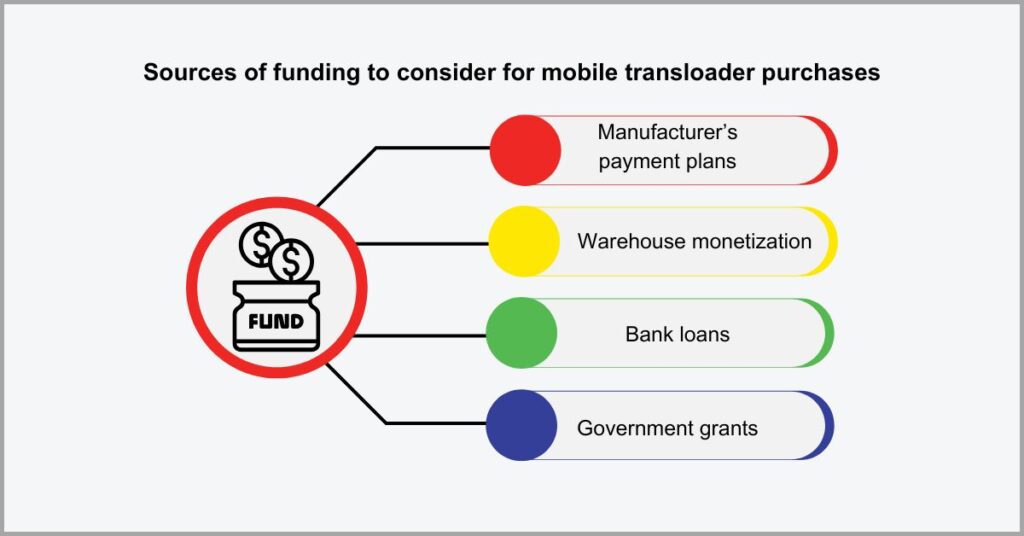
So how do you get around the price constraints?
Well, I recommend considering angel investors, grants and bank loans to help you raise capital without constricting your transload facility’s cash flow. Some equipment manufacturer’s also offer a payment plan that can cushion the financial burden as well.
You could also execute profitable warehouse business ideas besides transloading, such as offering freight forwarding, brokerage and truck parking services.
That said, a mobile transloading system can be a very worthwhile transloading equipment to consider investing in for your transload yard. It can result in huge productivity and efficiency gains that ensure excellent return-on-investment.
b. Overfilling and spilling
What challenges do you face during fluid transloading?
Transloading liquid bulk materials like butane, oil and industrial chemicals present the risk that you could fill tankers beyond their required capacity or accidentally cause spills.
When overfilling and spill incidents occur, you can damage transloading equipment and tankers and also risk violating spill containment regulations.
It’s alarming to note that 28,000 tonnes of oil was lost to spillages between 2020 and 2023, going by an ITPOF study. On the back of these statistics, it’s easy to understand why the government is clamping down on spills by enforcing stricter regulations.
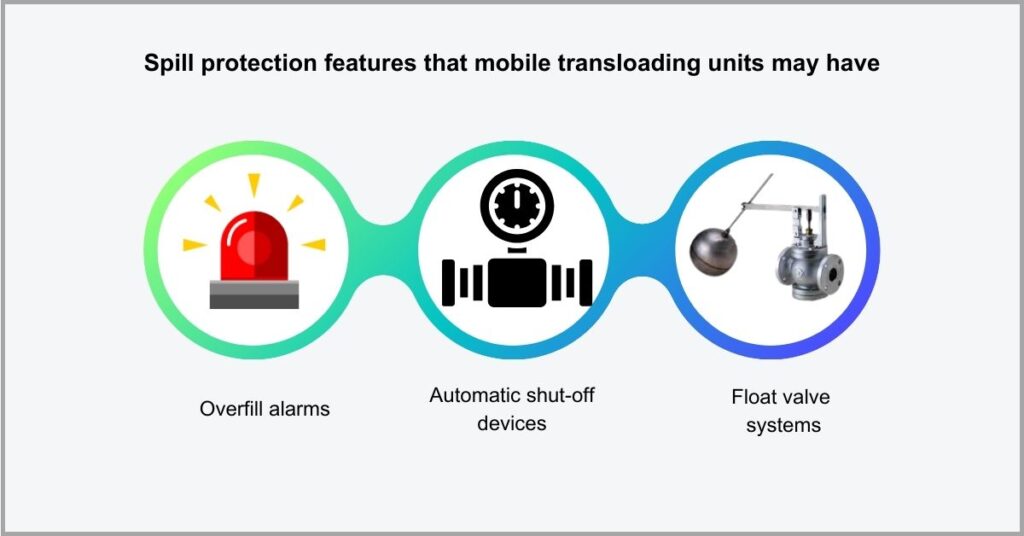
In order to ensure proper transloading spill containment when using a portable transloading system, I recommend that you choose a unit with the right safety features.
For instance, some mobile transloading units offer overfill alarms. Once the liquid reaches the desired level in the tanker, it will notify you to take action and turn off the valve to prevent it from overflowing and spilling.
Others may have automatic shut-off devices that come into play once the transloaded liquid reaches the target level. By prioritizing such spill and overfill prevention features, you can improve regulatory compliance and also minimize your environmental impact.
c. Additional compliance needs
Some portable transloaders require complementary tools.
For example, with trailer-mounted portable transloading units, you’ll require additional tools such as a trailer, which needs to pass regulatory requirements set by the US Department of Transportation (DoT).
So a mobile transloading system may attract additional equipment & compliance needs, increasing the cost and complications of acquiring and using these units.
A survey by PWC reported that 26% of companies rated the fear of non-compliance as a huge obstacle to adopting new technologies. In order to ensure successful implementation, it’s crucial to know what compliance regulations you’re up against.
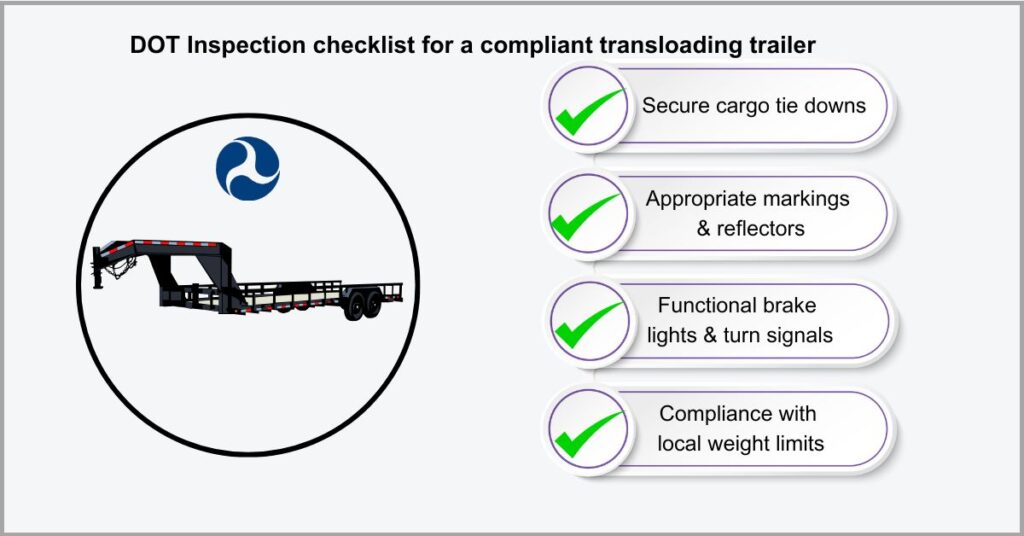
If you’ll be using the portable transloader for coal transload shipping and other types of transloading only within your facility, then you may not need to get a DOT-approved trailer since you can legally tow it within your premises.
However, if you’ll need to transport it via public road networks to reach client sites, then you’ll need to get a DOT worthy flatbed for moving the equipment.
Some of the requirements set by the DOT in this regard include the trailer matching the weight and size limit of the towing vehicle, using secure tie-downs for cargo, and observing proper trailer lighting and marking features, among others.
Conclusion
Inefficient transloading processes are bad for business.
They increase your labor needs while slowing down your transloading workflow.
With inefficient transloading systems, your business wastes a lot of time on labor and time-intensive tasks such as comprehensive liquid bulk cargo transfers.
The situation is very dire with 67% of logistics workers frustrated by manual and highly inefficient tasks, according to a Bizagi Study. In some cases, workers confessed to losing up to half of their work hours.
With a great mobile transloading unit, you can make certain transloading processes more efficient and automated. But such a tool can only take you so far. You also need an excellent transloading software solution that enables end-to-end automation.
Click here to book your free transloads.co demo to learn more about our software.
We’ll show you how to use our tool to automate tasks like inventory management and shipment tracking to streamline portable transloading operations & increase efficiency.

